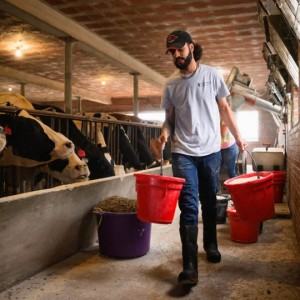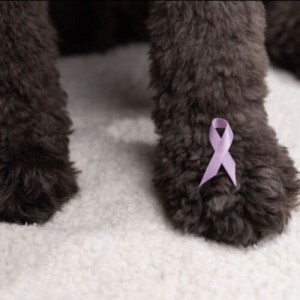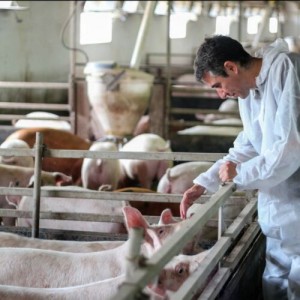Tanovea Fully Approved for Lymphoma Treatment in Dogs
What is Tanovea?
Tanovea is rabacfosadine, a double prodrug of 9-2-phosphonyl methoxy methyl guanine (PMEG), developed specifically as an anti-cancer drug for dogs. PMEG as an anticancer agent is limited, because the compound has poor cellular permeability and a high toxicity possibility, especially for the kidneys and gastrointestinal tract. A double prodrug, originally called GS-9219, was created that effectively loads the peripheral blood mononuclear cells with PMEG, and results in minimal plasma levels. Rabacfosadine readily accumulates in lymphoid tissue, especially rapidly dividing lymphoma cells, and mimics a nucleoside called guanine, a key DNA building block. Once inside the cells, Tanovea inhibits DNA synthesis, interrupts cell division, and causes cell death.
What conditions does Tanovea treat?
When prescribed and used appropriately by a licensed veterinarian, Tanovea has shown efficacy against the following diseases in dogs:
- Non-Hodgkin’s lymphoma (NHL) — Lymphocytes are a normal part of the immune system that protect the body from infection, but lymphomas can occur with abnormal lymphocyte growth. While lymphoma can affect any body organ in a dog, the disease most commonly arises in organs that play a role in the immune system, such as the lymph nodes, spleen, and bone marrow. The cause for lymphoma in dogs is unknown.
- Canine cutaneous T-cell lymphoma — When T-cell lymphocytes replicate abnormally and form nodules, plaques, or other skin lesions, cutaneous lymphoma occurs. The lesions are usually dry and scaly, and present with flaking skin and alopecia. The T-cell lymphocytes can produce a protein that causes hypercalcemia, and the affected dog may exhibit polyuria and polydipsia. Kidney damage is also possible.
- Spontaneous canine multiple myeloma — Plasma cell neoplasms, such as multiple myeloma, originate from terminally differentiated B lymphocytes that have undergone a malignant transformation. Clinical signs, including lethargy, weakness, and anorexia, are typically nonspecific and insidious at onset. The malignant plasma cells produce an immunoglobulin protein that can cause hyperviscosity syndrome, resulting in neurological signs, retinopathy, and cardiomyopathy. Other conditions include osteolysis, hemostatic disorders, cytopenias, hypercalcemia, and renal disease, and an increased susceptibility to bacterial infection.
- Naive canine multicentric lymphoma — The most common lymphoma in dogs is multicentric lymphoma, which first manifests in the dog’s lymph nodes, and can also affect the spleen, liver, and bone marrow. Signs include enlarged peripheral lymph nodes, lethargy, weight loss, anorexia, and polyuria/polydipsia.
- Relapsed canine B-cell lymphoma — Most dogs with large B-cell lymphoma who undergo chemotherapy and achieve clinical complete remission eventually relapse.
Is Tanovea effective?
A field effectiveness study using client-owned dogs diagnosed with multicentric B-cell or T-cell lymphoma compared Tanovea to a placebo. The Tanovea group included 112 dogs, and the placebo group included 36 dogs. Approximately half the dogs in each group had received prior chemotherapy treatment, and the dog’s cancer staging was similar in both groups. On day 0, the dogs received an IV infusion of Tanovea or the placebo over 30 minutes, and continued to receive the Tanovea or the placebo every 21 days for up to five cycles, until their lymphoma progressed, or they were withdrawn from the study. The primary goal was progression free survival (PFS).
The Tanovea group dogs had a median PFS of 82 days compared with 21 days in the placebo group dogs. The median PFS in the Tanovea group dogs who had either a complete or partial response was 151 days. For dogs with a complete response, the median PFS was 168 days. A complete response indicated the dog showed no evidence of disease, and a partial response indicated the cancerous lymph nodes had decreased in size by at least 30 percent when compared with the baseline. Five Tanovea group dogs had a complete response on day 365, which was the end of the study. Based on this data, Tanovea was determined effective when used according to the label.
Is Tanovea safe?
The most common adverse effects seen in dogs in the Tanovea and placebo groups were diarrhea, decreased appetite, vomiting, lethargy, and weight loss, but the side effects occurred more frequently and were more severe in the Tanovea group. Serious adverse events, such as pulmonary fibrosis, ear infections, hair loss, dermatitis, erythema, pruritus, hyperpigmentation, skin ulcerations, and bacterial skin infections, were more commonly reported in the Tanovea group.
Three laboratory studies were conducted to evaluate the safety and toxicity of rabacfosadine administered by IV infusion at various dosage regimens. Across all three studies, adverse reactions, including vomiting, abnormal feces, decreased activity, fever, dehydration, thinness, weight loss, decreased food consumption, and dermatopathies, were observed in dogs receiving the rabacfosadine. Two pilot studies were also conducted to support the labeled dosage regimen for Tanovea. These five studies showed that Tanovea has a narrow safety margin, which is not unexpected for an antineoplastic drug, but the conclusion was made that the drug is safe when used to treat lymphoma in dogs at the labeled dosage regimen.
What safety precautions should be taken with Tanovea?
West Highland white terriers are genetically predisposed to developing idiopathic pulmonary fibrosis, and Tanovea should not be used to treat lymphoma in this breed. In addition, Tanovea has potential safety concerns for people who handle, prepare, administer, or are exposed to the drug. The FDA recommends avoiding direct contact with a treated dog’s feces, urine, vomit, and saliva for five days after each treatment. Tanovea is cytotoxic and may cause birth defects and affect fertility in men and women. Women who are pregnant, may become pregnant, or are nursing should not handle, prepare, or administer the drug, or come in contact with a treated dog’s feces, urine, vomit, or saliva for five days after each treatment.
Tanovea is not only a valuable addition for lymphoma treatment in dogs, but can also be used in conjunction with traditional chemotherapy treatment to manage the disease.









List
Add
Please enter a comment